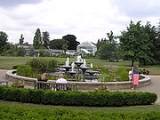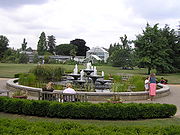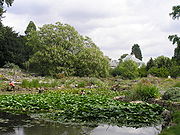
Cambridge University Botanic Garden
Encyclopedia

Botanical garden
A botanical garden The terms botanic and botanical, and garden or gardens are used more-or-less interchangeably, although the word botanic is generally reserved for the earlier, more traditional gardens. is a well-tended area displaying a wide range of plants labelled with their botanical names...
located in Cambridge
Cambridge
The city of Cambridge is a university town and the administrative centre of the county of Cambridgeshire, England. It lies in East Anglia about north of London. Cambridge is at the heart of the high-technology centre known as Silicon Fen – a play on Silicon Valley and the fens surrounding the...
, England
England
England is a country that is part of the United Kingdom. It shares land borders with Scotland to the north and Wales to the west; the Irish Sea is to the north west, the Celtic Sea to the south west, with the North Sea to the east and the English Channel to the south separating it from continental...
. It lies between Trumpington Road
Trumpington Road
Trumpington Road is an arterial road in southeast central Cambridge, England. It runs between the junction of Trumpington Street and Lensfield Road at the northern end to the junction of the High Street in the village of Trumpington and Long Street at the southern end...
to the west and Hills Road
Hills Road, Cambridge
This article is about the street. For the Sixth Form College commonly known as "Hills Road", see Hills Road Sixth Form CollegeHills Road is an arterial road in southeast Cambridge, England...
to the east, close to Cambridge railway station
Cambridge railway station
Cambridge railway station is a railway station serving the city of Cambridge in Cambridgeshire, England. It is located at the end of Station Road, off Hills Road, 1 mile south-east of the city centre...
. The garden covers an area of 16 hectare
Hectare
The hectare is a metric unit of area defined as 10,000 square metres , and primarily used in the measurement of land. In 1795, when the metric system was introduced, the are was defined as being 100 square metres and the hectare was thus 100 ares or 1/100 km2...
s (40 acres). The site is almost entirely on level ground and in additional to its scientific value, the garden is highly rated by gardening enthusiasts. It holds 10 National Collections. The botanic garden also forms an oasis of tranquility in Cambridge and is frequently used as a place to escape to for lunch by workers in the surrounding area. The garden was created for the University of Cambridge
University of Cambridge
The University of Cambridge is a public research university located in Cambridge, United Kingdom. It is the second-oldest university in both the United Kingdom and the English-speaking world , and the seventh-oldest globally...
in 1831 by Professor John Stevens Henslow
John Stevens Henslow
John Stevens Henslow was an English clergyman, botanist and geologist. He is best remembered as friend and mentor to his pupil Charles Darwin.- Early life :...
and was opened to the public in 1846.
Garden features

- Autumn colour garden
- Bed of British native plants
- Dry garden — demonstrates planting requiring reduced watering
- FenFenA fen is a type of wetland fed by mineral-rich surface water or groundwater. Fens are characterised by their water chemistry, which is neutral or alkaline, with relatively high dissolved mineral levels but few other plant nutrients...
display - GeneticsGeneticsGenetics , a discipline of biology, is the science of genes, heredity, and variation in living organisms....
garden - GlasshousesGreenhouseA greenhouse is a building in which plants are grown. These structures range in size from small sheds to very large buildings...
, containing about 3,000 species, have been restored and almost entirely replanted to display global plant diversity, and comprise:- Continents Apart, comparing and contrasting the fire dependent, floristically rich plant communities of South Africa and SW Australia, once conjoined in the supercontinentSupercontinentIn geology, a supercontinent is a landmass comprising more than one continental core, or craton. The assembly of cratons and accreted terranes that form Eurasia qualifies as a supercontinent today.-History:...
GondwanaGondwanaIn paleogeography, Gondwana , originally Gondwanaland, was the southernmost of two supercontinents that later became parts of the Pangaea supercontinent. It existed from approximately 510 to 180 million years ago . Gondwana is believed to have sutured between ca. 570 and 510 Mya,... - Oceanic Islands, exploring the floral diversity peculiar to island archipelagos
- Mountains, exploring how plants survive life in a cold climate
- Tropical Rainforests, a hotbed of competition
- Carnivores, displaying the diversity of traps in carnivorous plants
- Arid Lands, displaying drought tolerant plants from continental Africa and the Americas, including many Succulent and CactusCactusA cactus is a member of the plant family Cactaceae. Their distinctive appearance is a result of adaptations to conserve water in dry and/or hot environments. In most species, the stem has evolved to become photosynthetic and succulent, while the leaves have evolved into spines...
species, and demonstrating the phenomenon of convergent evolutionConvergent evolutionConvergent evolution describes the acquisition of the same biological trait in unrelated lineages.The wing is a classic example of convergent evolution in action. Although their last common ancestor did not have wings, both birds and bats do, and are capable of powered flight. The wings are...
. - Life Before Flowers, full of fernFernA fern is any one of a group of about 12,000 species of plants belonging to the botanical group known as Pteridophyta. Unlike mosses, they have xylem and phloem . They have stems, leaves, and roots like other vascular plants...
s and filmy ferns.
- Continents Apart, comparing and contrasting the fire dependent, floristically rich plant communities of South Africa and SW Australia, once conjoined in the supercontinent
- Herbaceous borders
- Lake

- National plant collections of:
- AlchemillaAlchemillaAlchemilla is a genus of herbaceous perennial plants in the Rosaceae, and a popular garden herb with the common name Lady's mantle. There are about 300 species, the majority native to cool temperate and subarctic regions of Europe and Asia, with a few species native to the mountains of Africa,...
- BergeniaBergeniaBergenia is a genus of ten species of flowering plants in the family Saxifragaceae, native to central Asia, from Afghanistan to China and the Himalayan region...
- European Fritillaria
- Lonicera
- RibesRibesRibes is a genus of about 150 species of flowering plants native throughout the temperate regions of the Northern Hemisphere. It is usually treated as the only genus in the family Grossulariaceae. Seven subgenera are recognized....
- RuscusRuscusRuscus is a genus of six species of flowering plants, native to western and southern Europe , Macaronesia, northwest Africa, and southwestern Asia east to the Caucasus. In the APG III classification system, it is placed in the family Asparagaceae, subfamily Nolinoideae...
- Saxifraga
- Species TulipTulipThe tulip is a perennial, bulbous plant with showy flowers in the genus Tulipa, which comprises 109 species and belongs to the family Liliaceae. The genus's native range extends from as far west as Southern Europe, North Africa, Anatolia, and Iran to the Northwest of China. The tulip's centre of...
s - Hardy Geraniums
- Alchemilla
Important scientific and research collections of:
-
- LavenderLavenderThe lavenders are a genus of 39 species of flowering plants in the mint family, Lamiaceae. An Old World genus, distributed from Macaronesia across Africa, the Mediterranean, South-West Asia, Arabia, Western Iran and South-East India...
- Lavender
- Rock gardens — for alpine plantAlpine plantAlpine plants are plants that grow in the alpine climate, which occurs at high elevation and above the tree line. Alpine plants grow together as a plant community in alpine tundra.-Alpine plant diversity:...
s- Limestone rock garden
- Sandstone rock garden
- Scented garden
- Systematic beds — 144 island beds representing 80 families of flowering plantFlowering plantThe flowering plants , also known as Angiospermae or Magnoliophyta, are the most diverse group of land plants. Angiosperms are seed-producing plants like the gymnosperms and can be distinguished from the gymnosperms by a series of synapomorphies...
s - Tree collection
- Water garden
- Winter garden (December to April)
- WoodlandWoodlandEcologically, a woodland is a low-density forest forming open habitats with plenty of sunlight and limited shade. Woodlands may support an understory of shrubs and herbaceous plants including grasses. Woodland may form a transition to shrubland under drier conditions or during early stages of...
garden — containing spring bulbs
Public events
Regular public events and courses are organised in the botanic garden including the hugely popular Apple day. Other events in 2005 included:- Tree Selection and Care
- Making Rush Baskets and Hats
- Illustrating Plants using Pen and Ink
- Painting the Autumn Harvest
- Wood: the Inside Story
- Gardening Seasons: Winter
- Winter Tree Identification
Many of these events are run or supported by the Friends of Cambridge Botanic Garden who support the garden by volunteering and helping raise funds.

